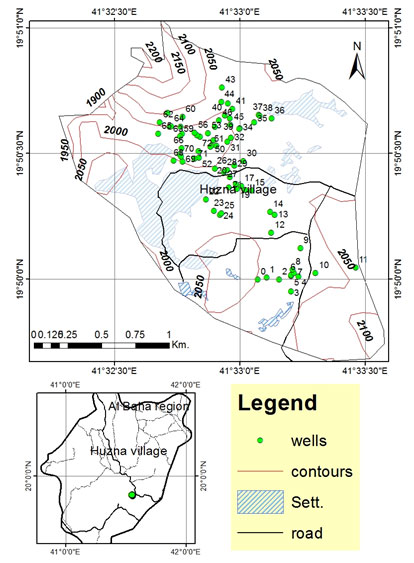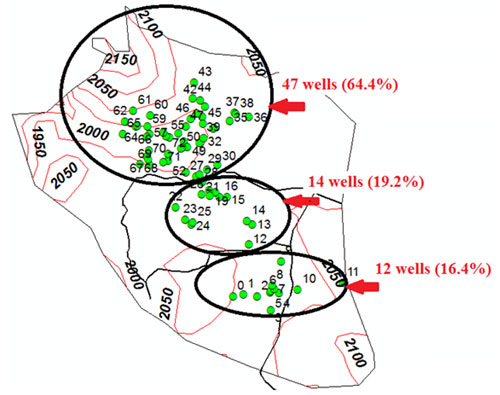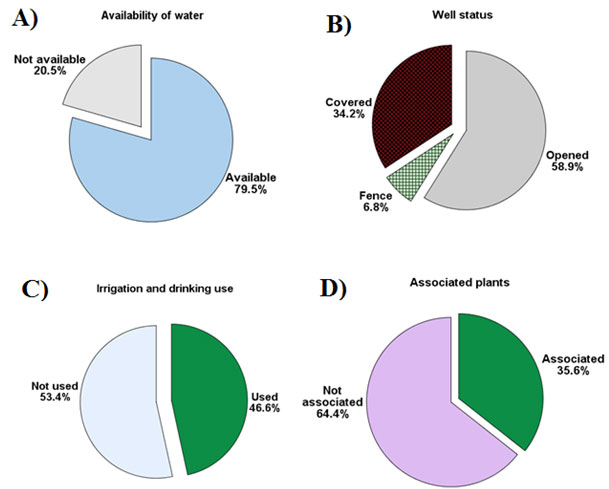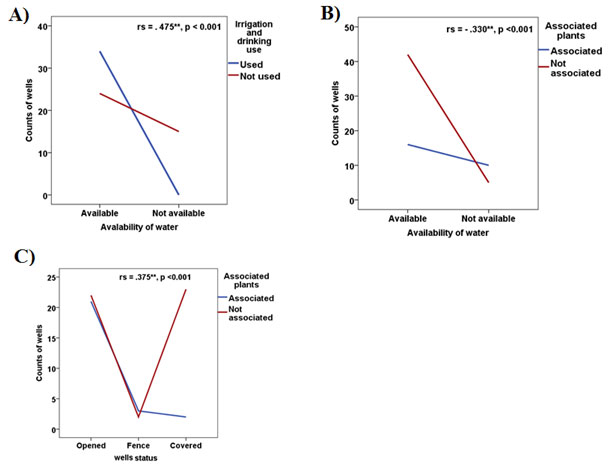Department of Biology, Faculty of Sciences and Arts in Baljurashi, Albaha University, Saudi Arabia PO. Box: 335 Zip Code: 22888
Corresponding author email: alibaggar@hotmail.com
Article Publishing History
Received: 19/02/2020
Accepted After Revision: 25/03/2020
This study aimed at evaluating 73 traditional wells in Hiznah village, Albaha region (Saudi Arabia). All information about the availability of water, well status, irrigation and drinking uses and associated plant species were recorded. The statistical method in terms of the determination of relationships between wells characteristics was analyzed using Spearman’s correlation coefficient. Forty-seven (65.75%) of wells were concentrated in the north of study area, 14 wells (17.81%) in the middle and 12 wells (16.4%) in the south of the study area. The majority of wells (79.5%) showed water availability and almost (46.6%) of such wells were used for both irrigation and drinking purposes. Approximately, 58.9% of wells were open followed by 34.2% and 6.8% of covered and fenced, respectively. Plant species were associated with 35.6% of open and fenced wells. The plant species were; Ficus palmata (31.5%), Celtus africana (2.7%) and Ficus vasta (1.4%). The availability of water in most wells may reflect the energy of groundwater to feed them, which they are concentrated in the north of the study site and this may due to increased recharged rates in these areas. Groundwater wells need further investigations regarding their quality to avoid any health hazards to crops, animals, and humans if water is to be used for irrigation and drinking.
Albaha, Hiznah, village, hydrology, wells, irrigation, drinking, topography.
Albaggar A. K. A. Evaluation of Traditional Wells in Hiznah Village, Albaha Region, Saudi Arabia. A Bond Strength Assessment. Biosc.Biotech.Res.Comm. 2020;13(1).
Albaggar A. K. A. Evaluation of Traditional Wells in Hiznah Village, Albaha Region, Saudi Arabia. A Bond Strength Assessment. A Bond Strength Assessment. Biosc.Biotech.Res.Comm. 2020;13(1). Available from: https://bit.ly/2UWYAuj
Copyright © Albaggar, This is an open access article distributed under the terms of the Creative Commons Attribution License (CC-BY) https://creativecommons.org/licenses/by/4.0/, which permits unrestricted use distribution and reproduction in any medium, provide the original author and source are credited.
INTRODUCTION
Freshwater is considered to be an important requirement for life, however, it represents only less than 3% of the total water volume in the world (Hahn, 2006). Groundwater is the one form of freshwater on earth and considered to be a renewable resource of water (APHA, 1998, 2012). Saudi Arabia is known as arid country and most of Saudi lands are deserts. The average of rainfall in Saudi Arabia is < 100 mm per year with no permanent lakes or rivers. The main sources of water are surface water, groundwater and desalination. The surface water consists of water that mainly captured in approximately 260 dam reservoirs. On the contrary, the amount of groundwater depends on the recharge rate which is higher in shallow wells than deep wells (Ouda, 2013). Groundwater in Saudi Arabia has long been used as the main source for the accomplishment of different purposes, such as domestic and agriculture supply, especially during 1970s and 1980s (Alsuhaimi et al., 2019).
The depth and water volume can be varied between traditional wells (hand-dug systems) (Yakubu, 2013). The agricultural sector consumes about 70% to 80% of freshwater in Saudi Arabia. However, up to five thousand litres of water are consumed for the production of 3 meals per person per day (Alsalah et al., 2015).In Saudi Arabia, quality assessments of groundwater have been studied previously (Al-Hasawi et al., 2018; Alsalah et al., 2015; Alsuhaimi et al., 2019; Bob et al., 2015; Ouda, 2013). To the best of author’s knowledge, evaluating large number of traditional wells in one village in terms of scientific explanations for the distribution of wells, availability of water, well status, associated plant species and the possibility of water utilization for drinking and irrigation have not been addressed yet. Thus, the main objectives of this study are to evaluate all traditional wells in Hiznah village, Saudi Arabia during 2019, and to determine the relationships between the characteristics of these wells.
MATERIAL AND METHODS
The study sites: The study area Hiznah is located west of Baljurashi, between lat. 19.85387 and lat. 19.827907 and between long. 41.53561 and 41.55814, with altitude ranges between 1900 and 2167 (Fig. 1). Hiznah is a 3 km² village located in the south of Albaha region, Saudi Arabia (Fig. 1). Almost 1.25 thousand people currently live in Hiznah village. All traditional wells of Hiznah village (73 wells) were selected during 2019, (Table 1). All information about each well in terms of the availability of water, well status, irrigation and drinking uses and associated plant species were recorded (Table 1).
Figure 1: The location of the study area with targeted wells (n=73) in Hiznah village in Albaha region (Saudi Arabia).
Statistical analysis: The statistical package of SPSS, version 20 (IBM) was used to analyze the data of wells characteristics (availability of water, well status, irrigation and drinking use and also associated plant species). Spearman’s rank correlations coefficient (rs) was applied to examine the relationships between wells characteristics (Field, 2009).
RESULTS AND DISCUSSION
In Hiznah village, numerous traditional wells (total of 73 wells) are distributed in its valley and were used for irrigation and drinking. Geographically, the wells were distributed as follow; 47 (64.4%) of wells were concentrated in the north of the village, 14 wells (19.2%) in the middle, and 12 wells (16.4%) in the south (Figure 3). Each well was owned by different families and each one of them had a day of watering. Each family also was responsible for maintaining and protecting the well.
Figure 2: The distribution of targeted wells (n=73). Forty-seven (65.75%) of wells are in the north of the village, 14 wells (17.81%) in the middle, and 12 wells (16.44%) are located in the south.
Area topography and recharge of wells:The age of Hiznah wells is unknown for exact. Structurally, most of the wells seem to be similar to each other reflecting the same period of time of the construction. The depth of the wells almost ranged from 15-25 m and the width range from 3 to 4 m. After precipitation of rain water, storing or moving of the water stream depends on geological locations (Plummer et al., 2013), topography, and climate (Condon & Maxwell, 2015; Grinevskii, 2014; Shahbazi et al., 1967). Groundwater moves from higher altitude areas to lower zones culminating in recharging of wells and increase water levels in this zone (Plummer et al., 2013).
In Hiznah village, wells are concentrated near agricultural fields located on the bottoms of the valleys and near the settlements, especially in the north of the study area at the southern side of Hiznah mountain where most wells (64.4%) were seen below Hiznah mountain (Figure 1). Indeed, the topography features of this region resembling a water basin that contributes to the conservation and recharge of groundwater in large quantities. Condon & Maxwell (2015) found a strong relationship between topographic gradients and the fluxes of groundwater.
Additionally, the study conducted by Rukundo & Dogan (2019) highlighted the role of spatial variations in determining groundwater recharge rates in the Ergene River catchment in Turkey. The middle part of Hiznah village contains a water basin that receives the water descends from the northern side of Madhan mountain and recharge the nearby wells (19.2%) (Figure 2). On the contrary, the wells in the south of Hiznah village represent (16.4%) of total wells (Figure 2). This area is rocky and surrounded by plateaus with agricultural terraces that absorb water and the wells are poorly fed as a result. Some of the water flows southward and not westward towards the boreholes. Also, the concentration of the population is low in this location compared to the north of the village. However, wells in this area are concentrated below the south of Madhan mountain.
Availability of groundwater: The availability of groundwater depends upon the recharge rates and not just the amount of residence water (Healy et al., 2007). These rates can be physically and directly measured by estimating water fluxes. Age of groundwater can be also estimated by tracing isotopes (Plummer et al., 2013). Availability of water in Hiznah village is presented in (Table 1) and (Figure 3A). Approximately 79.5% of the studied wells have water available, while just 20.5% of them showed no water available and this may be due to the low amount of rainfall that recharge groundwater.
Geologically, weathering, recharge rate, and human activities can affect the physicochemical and microbial quality of groundwater (Sethy et al., 2016; Yakubu, 2013). This water can be unsafe for drinking and irrigation due to numerous health hazards that result from polluted water (WHO, 2017). The open system represents the majority of wells (58.9%), while covered and fenced wells represent 34.2% and 6.8%, respectively (Figure 3B). This open system in the village may affect the quality of water in terms of the ease of pollutants to access the water from the surrounding area.
Table 1. Characters of targeted wells in Hiznah village, Albaha region, KSA (n=73).
| Character of wells | Location | Total | ||
| North | Middle | South | ||
| Wells with available water n (%) | 41 (70.69) | 11 (18.96) | 6 (10.34) | 58 (79.45) |
| Wells used for drinking & irrigation n (%) | 26 (78.79) | 5 (15.15) | 3 (9.09) | 33 (45.20) |
| Well status | ||||
| Covered | 15 (65.22) | 4 (17.39) | 4 (17.39) | 23 (31.51) |
| Fenced | 4 (57.14) | 2 (28.57) | 1 (14.28) | 7 (9.59) |
| Open | 29 (67.44) | 7 (16.28) | 7 (16.28) | 43 (58.90) |
The uses of water for drinking and irrigation in Hiznah village are presented in (Table 1) and (Figure 3C). Approximately, 46.6% of wells that have water available are used for drinking and irrigation, while other wells (53.4%) are not used for the same purposes. The reason for the low use in the village is that some people are no longer interested in agriculture because they are tenured governmental employees with a higher income than the agricultural sector. In addition, drinking water is now available via public municipal networks (desalination).
Associated plants species
Plant species associated with open wells in Hiznah village are presented in (Table 1) and (Figure 3D). Approximately, 35.6% of plant species associated with open and fence system of the top of wells, while the remaining covered wells (64.4%) showed no association with any pant species. The natural plant species were Ficus palmata (31.5%), Celtis africana (2.7%) and Ficus vasta (1.4%) (locally called Hamat, Shopareq, and Roqqah, respectively).
These three species are recorded from Albaha region, Ficus palmate and Fecus vasta are recorded between 1800 and 2800 m, and Celtis Africana between 1500 and 2500 m. The three species are not harmful and have economic uses (Al-Khulaidi, et al., 2016). A study on rare and endangered plant species in Albaha region conducted by Al-Khulaidi, et al., (2018) considered Celtis africana and Ficus vasta are rare species with frequency percentage of 1.56 and 1.25, respectively.
Green and blue-green algae are common and can be found in well water. The distinct green color in water can result from green algae with no potential health hazards. However, certain cyanobacteria (blue green algae) can produce toxins in the water that can be harmful to humans and animals (Gerba & Pepper, 2019; Sheath & Wehr, 2003). Up to 5.5% of wells showed a growth of green algae floated on the surface of water. All are open wells located in the north of the village and are not used for drinking and irrigation. The growth of green Algae in these wells may as a result of agriculture activities (in the form of fertilizers) and wastes of humans and animals, reaching into wells through runoff. Mohamed & Al-Shehri (2008) identified two cyanobacterial species (Chroococcus minutus and Pannus spumosus) in all samples of groundwater wells in Asir in Saudi Arabia. These species are known to produce toxins and can be harmful to human (Karan et al., 2017; John et al., 2015). In the investigation of twenty wells in Arar city in Saudi Arabia, Al-Shaikh (2017) detected six types of algae in four water wells. These types are Amphora, Navicula, Nitzschia, Euglena, Cyclotella and Opephora. This study recommended that the proper treatment of some wells water should be done before drinking.
Table 2. Number of wells associated with different plant species in different locations of Hiznah village, Albaha region, KSA
| Plant | Well’s location | ||
| North | Middle | South | |
| Celtis africana | 1 (2.08) | 0 (0) | 0 (0) |
| Ficus palmata | 17 (35.42) | 3 (23.08) | 3 (25) |
| Ficus vasta | 1 (2.08) | 0 (0) | 0 (0) |
Significant relationships between characteristics of wells: Correlations analysis between all characteristics of wells in Hiznah Village is presented in table 3 and figures 4. The availability of water was positively correlated with irrigation and drinking use (rs =0 .475**, p < 0.001) (Figure 4A). However, the availability of water was negatively correlated with associated plant species (rs = – 0.330**, p < 0.001) (Figure 4B). Well statuses were positively correlated with associated plant species (rs = .375**, p < 0.001) (Figure 4C). Open and fenced systems of wells in the village showed the growth of plant species.
Figure 3. Overall characteristics of wells and their utilization purposes in Hiznah village, KSA.
Table 4: Relationships between different characteristics of wells in Hiznah village, Albaha region Saudi Arabia
| characteristics | Availability of water | Well status | Irrigation and drinking use | Associated plants |
| Availability of water | – | N.S. | rs = .475**,
p < 0.001 |
rs = -.330**,
p < 0.001 |
| Well status | N.S. | – | N.S. | rs = .375**,
p < 0.001. |
| Irrigation and drinking use | rs = .475**,
p < 0.001 |
N.S. | – | N.S. |
| Associated plants | rs = -.330**,
p < 0.001 |
rs = .375**,
p < 0.001. |
N.S. | – |
Key symbols: SU: standard unit, N.S.: not significant, rs: Superman’s rank correlation.
Figure 4: Relationship between wells’ characters in Hiznah village, Albaha region, Saudi Arabia. Association of availability of water with utilization purposes (A), water availability and presence of associated plants (B), and well status association with plant presence (C).
ACKNOWLEDGEMENT
The author would like to thank Ahmed Tohman Alghamdi for his help in naming all traditional 73 wells in Hiznah village. The author would like also to thank other inhabitants in Hiznah village for their help and support. Especial thanks go to Dr. Abdul Wali Al-Khulaidi for his support in GIS mapping.
REFERENCES
Al-Hasawi, Z. Al-Hasawi, R. and S. Al-Zahrani, S.: (2018).
The study of some physicochemical and microbiological properties in water wells at Rabigh governate, Saudi Arabia. J. Biosci. Appl. Res., 4, 169-183
Al-Khulaidi, A. Al-Sagheer, N. Al-Turki, T. and F. Filimban: (2018) Inventory of most rare and endangered plant species in Albaha region, Saudi Arabia. International Journal of Biology, Pharmacy and Allied Sciences (IJBAS), 7, 443-460.
Al-Khulaidi, A. Al-Sagheer, N. Dharfawi, M. and S. Al-Qhamidi: (2016) Tress of Albaha region and surrounding areas. FAO (http://www.fao.org/3/a-i6725a.pdf).
Alsalah, D. Al-Jassim, N. Timraz, K. and P.Y. Hong: (2015) Assessing the groundwater quality at a Saudi Arabian agricultural site and the occurrence of opportunistic pathogens on irrigated food produce. Int. J. Environ. Res. Public Health, 12, 12391-12411.
Al-Shaikh, T.M.: (2017) Study of microbial characteristics of well groundwater in the city of Arar, Kingdom of Saudi Arabia. J. North Basic Appl. Sci., 2, 41-50.
Alsuhaimi, A.O., Almohaimidi, K.M., and K.A. Momani: (2019) Preliminary assessment for physicochemical quality parameters of groundwater in Oqdus Area, Saudi Arabia. J. Saudi Soc. Agric. Sci., 18, 22-31.
APHA: (1998) Standard Methods for Examination of Water and Wastewater. 20th Edn., APHA, AWWA, WPCF, Washington DC, USA.
APHA: Standard Methods for Examination of Water and Wastewater. 22nd Edn., APHA, AWWA, WPCF, Washington DC, USA (2012).
Bob, M. Abd Rahman, N. Taher, S. and A. Elamin: (2015) Multi-objective assessment of groundwater quality in Madinah city, Saudi Arabia. Water Qual. Expo. Health, 7, 53-66.
Chao, S. Fan, J. and L. Wang: (2016) Association between the levels of calcium in drinking water and coronary heart disease mortality risk: evidence from a meta-analysis. J. Clin. Exp. Med., 9, 17912-17918.
Condon, L.E. and R.M. Maxwell: (2015) Evaluating the relationship between topography and groundwater using outputs from a continental‐scale integrated hydrology model. Water Resour. Res., doi: 10.1002/2014WR016774
Fan, A.M. and V.E. Steinberg: (1996) Health implications of nitrate and nitrite in drinking water: an update on methemoglobinemia occurrence and reproductive and developmental toxicity. Regul. Toxicol. Pharmacol., 23, 35-43.
Field, A.P: (2009) Discovering statistics using SPSS: and sex and drugs and rock ‘n’ roll. 3rd Edn., SAGE publications Ltd, London, UK.
Gerba, C.P. and I.L. Pepper: (2019) Microbial Contaminants. In: Environmental and Pollution Science. 3rd Edn., (Eds.: M.L. Brusseau, I.L. Pepper and C.P. Gerba). Academic Press, Boston, p. 191-217.
Grinevskii, S.O.: (2014) The effect of topography on the formation of groundwater recharge. Moscow Univ. Geol. Bull., 69, 47-52.
Hahn, M.W.: (2006) The microbial diversity of inland waters. Curr. Opin. Biotechnol., 17, 256-261.
Healy, R.W. Winter, T.C. Labaugh, J.W. and O.L. Franke: (2007) Water budgets: Foundations for effective water-resources and environmental managment. U.S. Virginia: Geological Survey 1308.
John, D. W., Robert, G. S., and J. P. Kociolek: (2015) Freshwater algae of North America: Ecology and Classification. 2nd Edn., USA.
Karan, T., Altuner, Z., and R. Erenler: (2017) Growth and metabolite production of Chroococcus minutus under different temperature and light conditions. Journal of New Results in Science (JNRS), 6, 47-52.
Mohamed, Z.A. and A.M. Al-Shehri: (2008) Cyanobacteria of surface and ground waters in Asir region with new records to Kingdom of Saudi Arabi. J. King AbdulAziz Univ., 20, 113-129.
Omer, E.O.M. Algamidi, A.A. Algamidi, I. M. Fedlelmula, A. and A.S.R. Alsubaie: (2014) The hygienic-related microbiological quality of drinking water sources Al-Baha Province, Kingdom of Saudi Arabia. J. Health Spec., 2,.
Otu, R.A. Agyenim, J.B. and G.B.N. Bumah: (2014) Correlation analysis of groundwater colouration from mountainous Areas, Ghana. Environ. Res. Eng. Manage., 1, 16-24.
Ouda, O.K.M.: (2013) Towards assessment of Saudi Arabia public awareness of water shortage problem. Resour. Environ., 3, 10-13.
Plummer, L.N. Sanford, W.E. and P.D. Glynn:(2013) Characterization and conceptualization of groundwater flow systems. In: Isotope methods for dating old groundwater. (Eds.: A. Suckow, P. K. Aggarwal, and L. A. Araguás). International Atomic Energy Agency, Vienna, p. 5-20
Rukundo, E. and A. Dogan: (2019) Dominant influencing factors of groundwater recharge spatial patterns in Ergene River catchment, Turkey. J. Water, 11, 653 (2019). doi: 10.3390/w11040653
Sethy, S.N. Syed, T.H. Kumar, A. and D. Sinha: (2016) Hydrogeochemical characterization and quality assessment of groundwater in parts of Southern Gangetic Plain. Environ. Earth Sci., 75, 232. doi: 10.1007/s12665-015-5049-4
Shahbazi, M. Zand, S. and D.K. Todd: (1967) Effect of topography on ground water flow. paper for presentation to Inter. soc. of Sci. Hydrology ,14th General Assembly, IUGG. September 1967, Berne, Switzerland, 314-319.
Sheath, R. and J. Wehr: (2003) Introduction to Freshwater Algae. Freshwater Algae of North America: Ecol. Classif., 1-9. doi: 10.1016/B978-012741550-5/50002-7
WHO: (2017) Guidelines for drinking water quality. 4th Edition incorporating the first addendum. Geneva: World Health Organization.
Yakubu, S.: (2013) Assessment of water quality of hand-dug wells in Zaria LGA of Kaduna State, Nigeria. Int. J. Eng. Sci., 2, 01-04.






